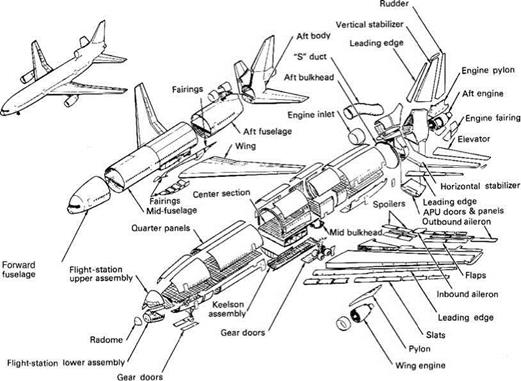Civil Aircraft and Its Component Configurations
In general, the civil aircraft category includes five types: (1) small club trainers, (2) utility aircraft, (3) business aircraft, (4) narrow-body commercial transporters (regional aircraft to midsize), and (5) wide-body large transporters. The various types of available configuration options are described in Chapter 4. The aircraft components shown in Figure 2.3 are some of the obvious ones (e. g., wing, fuselage, nacelle, and empennage); others (e. g., winglets, strakes, and auxiliary control surfaces) are less obvious but play vital roles – otherwise, they would not be included. Because there are many options, components are associated in groups for convenience, as described in the following subsections (refer to Figure 2.3).
|
Figure 2.3. Lockheed 1011 diagram (courtesy of Michael Niu [10]) |
Fuselage Group
This group includes the nose cone, the constant midsection fuselage, the tapered aft fuselage, and the tail cone. The fuselage belly fairing (shown in Figure 2.3 as several subassembly components below the fuselage) may be used to house equipment at the wing-fuselage junction, such as the undercarriage wheels.
Wing Group
This group consists of the main wing, high-lift devices, spoilers, control surfaces, tip devices, and structural wing box that passes through the fuselage. High-lift devices include leading-edge slats or trailing-edge flaps. In Figure 2.3, the leading-edge slats are shown attached to the main wing and the trailing-edge flaps and spoilers are shown detached from the port wing. Spoilers are used to decelerate aircraft on descent; as the name suggests, they “spoil” lift over the wing and are useful as “lift dumpers” on touchdown. This allows the undercarriage to more rapidly absorb the aircraft’s weight, enabling a more effective application of the brakes. In some aircraft, a small differential deflection of spoilers with or without the use of ailerons is used to stabilize an aircraft’s rolling tendencies during disturbances. In Figure 2.3, the wing is shown with winglets at the tip; winglets are one of a set of tip treatments that can reduce the induced drag of an aircraft.
Empennage Group
The empennage is the set of stability and control surfaces at the back of an aircraft. In Figure 2.3, it is shown as a vertical tail split into a fin in the front and a rudder at
the back, with an end cap on the top. The horizontal tail, shown as a T-tail set at the top of the vertical tail, consists of the stabilizer and the elevator. Canard configuration has ‘tail’ in front.
Nacelle Group
Podded nacelles are slung under the wings and one is mounted on the aft fuselage; pylons affect the attachment. Engines can be mounted on each side of the fuselage. The nacelle design is discussed in detail in Chapter 10. Turbofans are preferred for higher subsonic speed.
Undercarriage Group
The undercarriage, or landing gear, usually consists of a nose-wheel assembly and two sets of main wheels that form a tricycle configuration. Tail-dragging, bicycle, and even quad configurations are possible, depending on the application of an aircraft. Wheels are usually retracted in flight, and the retraction mechanism and stowage bay comprise part of the undercarriage group. Undercarriage design is discussed in Chapter 7.
Not shown in Figure 2.3 are the trimming surfaces used to reduce control forces experienced by the pilot. During the conceptual phase, these surfaces generally are shown schematically, with size based on past experience. The sizing of trim surfaces is more appropriate once the aircraft configuration is frozen (i. e., a Phase 2 activity). Trim-surface sizing is accomplished by using semi-empirical relations and is fine-tuned by tailoring the surfaces and areas or adjusting the mechanism during flight trials. In this book, trim surfaces are treated schematically – the main task is to size the aircraft and finalize the configuration in Phase 1. On larger aircraft, powered controls are used; pitch trimmings in conjunction with moving tail planes. A propeller-driven aircraft is preferred for cruise speeds below Mach 0.5.












